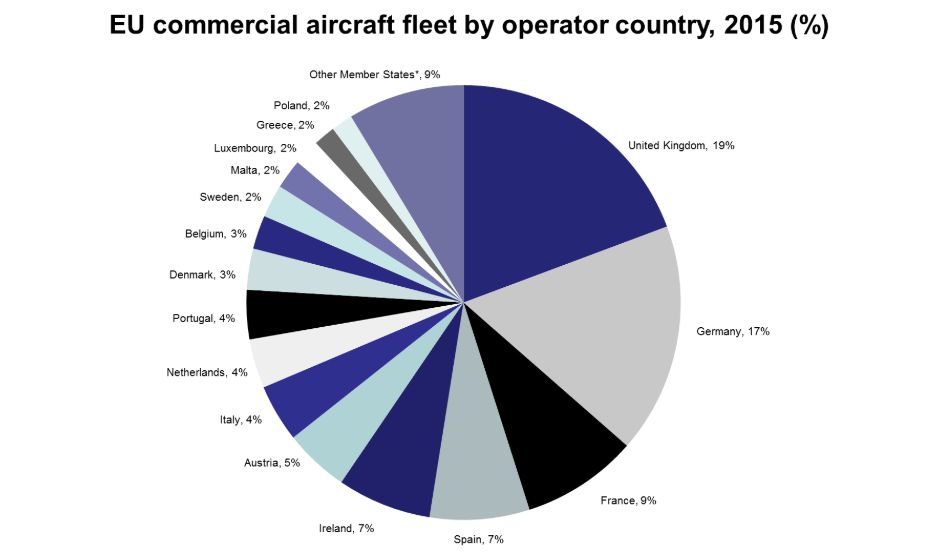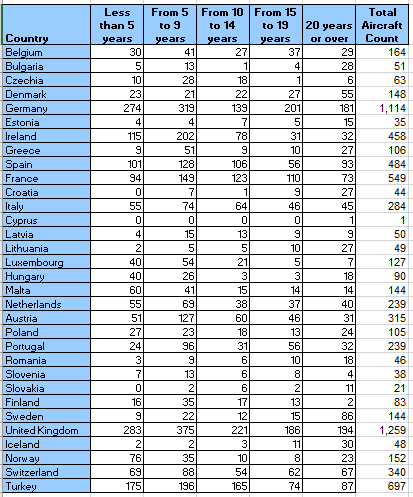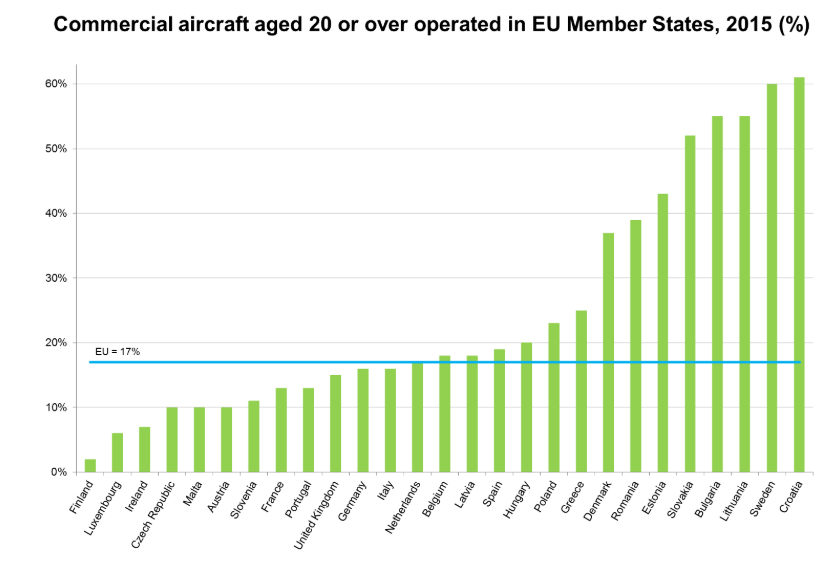The following white paper considers a number of challenges faced by EASA Regulatory Authorities to engage with a Performance-Based Approach in this case with ) Aircraft continuing airworthiness monitoring (ACAM) (however there is a read across into SMS)
Steve Bentley is MD of Sofema Aviation Services www.sassofia.com
Small Fleets
Some European Countries operate relatively small fleets, reference above graphic Bulgaria with its commercial fleet of 50 Aircraft features as “other member states”
Does it Matter?
Well yes if you are regulator using a set of Performance Based Criteria which requires regulators to take “ownership” for individual analysis.
Only where the competent authority understands fundamental exposure related to lack of competence and is able to address this as exposure can “Performance Based” oversight fully engage with the objective.
Why ACAM?
A careful read of the regulatory objectives shows that a primary objective of the ACAM process is to improve the efficiency of the CA oversight process – beneficial for large fleets of less use for smaller fleets.
Note 1 – However there may even be negative considerations where a competent authority responsible for a smaller fleet over-focuses on KRE criteria which is not necessarily a “Root Cause” exposure and in so doing actually missing Organisational Shortfalls
What Level of Staff is “Empowered” to make performance-based decisions?
So here is the challenge
If you give me a prescriptive objective I can respond with Yes or No and respond accordingly – If you give me a Performance-Based decision, I (The Auditor) has to determine an exposure based on my (Their) competence to do so.
So suddenly with performance auditing, we are now “responsible” for our decision in away that was not the case with Compliance auditing
AMC1 M.B.303(a) Aircraft continuing airworthiness monitoring (ACAM)
ACAM SURVEY PROGRAMME — SCOPE
1. The competent authority should establish a programme covering in-depth surveys and ramp surveys.
2. The competent authority’s survey programme should select aircraft and/or operators depending on the number and complexity of aircraft on the national register, the diversity of aircraft types, local knowledge of the maintenance environment and operating conditions, airworthiness standards and past surveillance experience.
3. The programme should prioritise the operator/fleet/aircraft/key risk elements which are causing the greatest concern.
DATA is everything in the ACAM story
Consider the following table
Germany and the UK have more than 1000 Aircraft several countries have some 100’s Bulgaria has 50 Aircraft
Clearly, it is not a 1 size fits all approach – it is not possible to apply the same criteria/methodology which works for a large fleet directly to a smaller fleet.
In theory, the development of performance-based criteria will provide the necessary tool and methodology – (but not if the regulator is not able to engage with performance-based decisions applicable to the determination and exposure to risk.
The Roll of Aircraft Age
Clearly, the older the aircraft the greater is the need for competence persons to manage the continuing airworthiness. This should be taken into consideration during any oversight audits.
Any European Authority with more than 50% of the fleet over 20 Years old should be paying particular attention to the ability of the organisation’s competence to manage ageing aircraft.
Root Cause / Direct Cause / Contributing Cause
The ACAM key risk elements are NOT related to Root Cause rather they are related to either Direct or Contributing Elements.
If we are to address the Root Cause we need to look not aircraft by aircraft but directly at the organisation and to ask the questions
1) How is the organisation assessing its “success” at managing the KRE equivalents
2) How is it (The Organisation) managing the competence of persons engaged in the ACAM related KRE organisation oversight process?
NOTE 1 – EASA has provided no guidance on the Competence within a CAMO – Therefore what Do you expect to see as a Competent Authority.
3) How does the Organisation manage its data in particular for small data sets where the criteria is based on Qualitative decision-making processes (Again Competence)
EASA Requirements
SCOPE OF SURVEYS
1. The competent authority should undertake sample product surveys of aircraft on it’s registered to verify that:
(a) the condition of an aircraft as sampled is to a standard acceptable for the Certificate of Airworthiness/Airworthiness Review Certificate to remain in force,
(b) the operator/owner’s management of the airworthiness of the aircraft is effective,
(c) the approvals and licenses granted to organisations and persons continue to be applied in a consistent manner to achieve the required standards.
A physical inspection of the aircraft is necessary during each ACAM survey (ramp or in-depth).
2. Sample product surveys of aircraft include:
(a) in-depth surveys carried out during extensive maintenance that fully encompass selected aspects of an aircraft’s airworthiness,
(b) ramp surveys carried out during aircraft operations to monitor the apparent condition of an aircraft’s airworthiness.
3. When performing a ramp survey, the inspector(s) should make all possible efforts to avoid an unreasonable delay of the aircraft inspected.
4. The further information on ‘KEY RISK ELEMENTS’ can be found in Appendix III to GM1 M.B.303(b). AMC2 M.B.303(b) Aircraft continuing airworthiness monitoring ED Decision 2015/029/R
IN-DEPTH SURVEY
1. An ACAM in-depth survey is a sample inspection of the key risk elements (KREs) and should be performed during scheduled/extensive maintenance. Appendix III to GM1 M.B.303(b) provides guidance on KREs that can be used for planning and/or analysis of the inspections.
2. The survey should be a ‘deep cut’ through the elements or systems selected.
3. The record of an ACAM inspection should identify which KREs were inspected.
AMC3 M.B.303(b) Aircraft continuing airworthiness monitoring
KEY RISK ELEMENTS
1. The following KREs should be used for aircraft continuing airworthiness monitoring:
(a) Type design and changes to type design
(b) Airworthiness Limitations
(c) Airworthiness Directives
(d) Aircraft documents
(e) Flight Manual
(f) Mass & Balance
(g) Markings & placards
(h) Operational requirements
(i) Defect management
(j) Aircraft Maintenance Programme
(k) Component control
(l) Repairs
(m) Records
2. These KREs and their detailed components should be adapted to the complexity of the aircraft type being surveyed by retaining only those items that are applicable and relevant for the particular aircraft type.
Delivering a Root Cause Assessment based on Key Risk Element Criteria in a Smaller Fleet
Without large fleet data, it is not so easy to build up data sets as value indicators.
Therefore compensation should be sought by engaging further with performance-based questions which dig deeper not just into the physical -sample aircraft, but into the Organisations ability to Manage itself.
Sofema Aviation Services www.sassofia.com and SofemaOnline www.sofemaonline.com provide regulatory and vocational training and consulting for both regulatory authorities and industry.
Please email office@sassofia.com or online@sassofia.com







